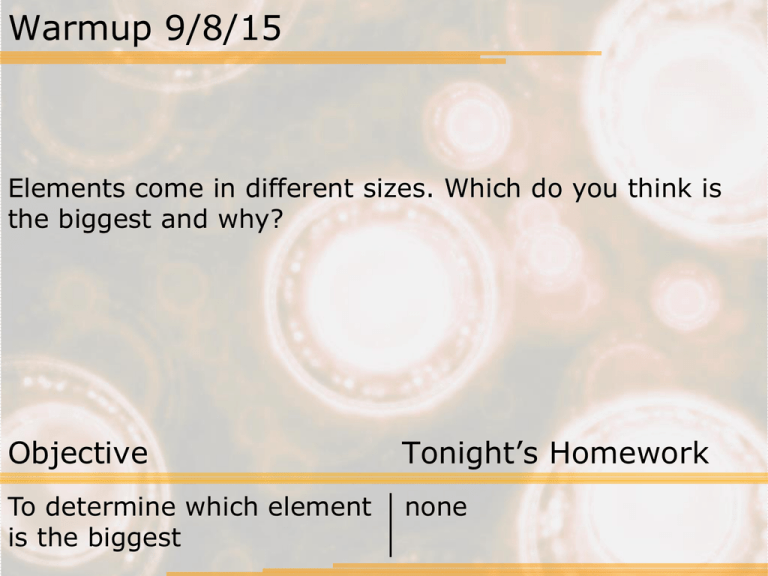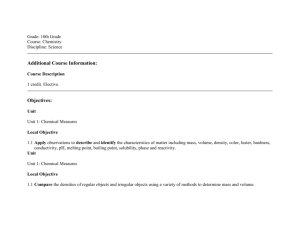Atomic Size
advertisement

Warmup 9/8/15 Elements come in different sizes. Which do you think is the biggest and why? Objective Tonight’s Homework To determine which element is the biggest none Trends in the Periodic Table We’ve looked at many things so far, but we haven’t focused much on the periodic table. We’re going to review a few things on the table. The goal here is that you get a bit of appreciation for just how well-laid out this table is. Trends in the Periodic Table Atomic Size This trend refers to the size of each atom. Which is the biggest? How do we define the edge? Trends in the Periodic Table Atomic Size This trend refers to the size of each atom. Which is the biggest? How do we define the edge? Since electrons pop in and out of existence, “edge” is a bit hard to define. But we can define it roughly as the level where the outer electrons are. Trends in the Periodic Table So what kind of sizes are we talking about? Atoms are in picometers. 1 picometer = 1/1,000,000,000,000 of a meter Trends in the Periodic Table So what kind of sizes are we talking about? Atoms are in picometers. 1 picometer = 1/1,000,000,000,000 of a meter Smallest atom: Helium – 31 pm Biggest atom: Cesium – 298 pm Trends in the Periodic Table So what kind of sizes are we talking about? Atoms are in picometers. 1 picometer = 1/1,000,000,000,000 of a meter Smallest atom: Helium – 31 pm Biggest atom: Cesium – 298 pm Add these two to your periodic table. Let’s see if there’s a trend as well… Trends in the Periodic Table Atomic Size Trends in the Periodic Table Atomic Size Larger atomic size to the left and down Trends in the Periodic Table Huh. Pretty neat that this follows such a clean pattern, right? Let’s see what other patterns there are… Trends in the Periodic Table Ionization Energy This is the amount of energy that it takes to rip off the outermost electron from the atom. Remember, each atom wants to fill up its ‘s’ and ‘p’ shells. This means each atom wants 8 electrons in outer shells. Trends in the Periodic Table Ionization Energy This is the amount of energy that it takes to rip off the outermost electron from the atom. Remember, each atom wants to fill up its ‘s’ and ‘p’ shells. This means each atom wants 8 electrons in outer shells. At the top of your table, you wrote the numbers 1 through 8. These show how many electrons are in the outer shells. Trends in the Periodic Table So how much energy does it take to rip off that outer electron? Trends in the Periodic Table So how much energy does it take to rip off that outer electron? Lowest: Cesium – 380 kiloJoules / mole Highest: Helium – 2370 kiloJoules / mole Trends in the Periodic Table So how much energy does it take to rip off that outer electron? Lowest: Cesium – 380 kiloJoules / mole Highest: Helium – 2370 kiloJoules / mole What this means is that for every mole of Cesium you have, you will have to use 380 kiloJoules of energy to rip the outermost electron from all of those atoms. Look at your periodic table. See a pattern again? Trends in the Periodic Table Ionization Energy Higher Ionization Energy Up and to the Right Exit Question Which element is the biggest? a) Helium b) Gold c) Hydrogen d) Radon e) Rubidium f) Cesium


